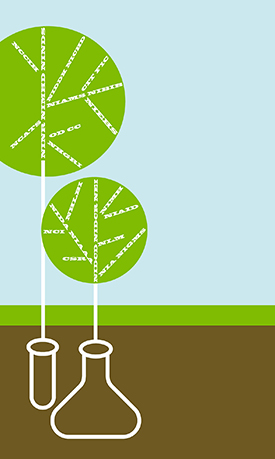News You Can Use: Green Labs
How to Make Your Lab Go Green

There’s a lot of talk these days about labs “going green” in an effort to reduce their environmental footprint and promote sustainable laboratory practices. But what does “going green” mean exactly, and how do you go about it?
Some of the basic fundamentals of a green lab include conserving energy and water, reducing waste, and recycling. Proper disposal of chemical, medical, and radioactive waste in safe, environmentally friendly ways plays an additional critical role in supporting sustainability. Even using “green” chemicals should be considered as part of the effort to “go green.”
The good news is that several NIH labs already meet the green-labs criteria. But, until now, there has been no official process for recognizing them. For the first time, eligible labs can be assessed and certified as green labs under a new initiative sponsored by the Green Labs Program.
The Green Labs Program aims to encourage “going green” in NIH laboratories, to conserve natural resources, and to protect the health of the environment and the people who live in it. Any lab wishing to be certified as a green lab—and receive recognition for participating in safe and sustainable practices—completes an online application that includes a self-assessment tool and submits it for consideration. After the form is submitted, applicants will be notified of results within two weeks. Labs meeting the award criteria will receive a Green Labs certificate. For more information and an application form, go to the NIH Green Labs Program website.
Taking a deeper dive into “going green,” some notable laboratory applications of sustainable environmental practices include using energy-efficient freezers and other lab equipment; replacing wet-chemistry photo processing with digital-imaging techniques; reducing chemical waste and cost by the minimal usage of radioisotopes, methanol, and X-ray film; and using green products as safer alternatives to certain toxic chemicals. For example, try semidry transfer techniques for Western blot analysis to avoid the use of methanol, limit waste, and save time and energy. Throughout the campus, there’s been increased use of safer substitutes for ethidium bromide. Labs are also trying environmentally friendly DNA-purification and DNA-isolation kits that use significantly less plastic and are available in recyclable packaging.
In the electrophoresis realm, the National Institute on Deafness and Other Communication Disorders (NIDCD) is playing a role: The Section on Human Genetics (in the Laboratory of Molecular Genetics) has an E-Gel Agarose Gel Station with a digital imager that uses less power than a large agarose gel-electrophoresis box. The gels come prestained with either ethidium bromide or SYBR Green, and, to increase safety, they are encased in plastic so the stain does not leak out.
Water-filtration systems can be made eco-friendly, too. For instance, NIDCD replaced its bottled laboratory-grade water system with a water-filtration system that undergoes preventative maintenance once a year and constantly monitors water quality so that NIDCD can be sure that no plastics leach into and contaminate the water. The Genetics and Metabolism Section (in the Liver Diseases Branch) in the National Institute of Diabetes and Digestive and Kidney Diseases (NIDDK) is using another system to provide metal-free water.
Another green technique involves taking lab notes in a way that has a less-harmful effect on the environment. For instance, researchers in NIDDK’s Gene Structure and Disease Section (in the Laboratory of Cell and Molecular Biology), use a web-based electronic notebook that can store, organize, and publish data, maintain multiple backups of data, save paper, and free up lab space that can be used for storing other items.
Other sustainable practices include using refillable pipette-tip racks that reduce plastic waste because the tip box can be used many times. In addition, NIDDK is using small equipment such as small centrifuges and a NanoDrop spectrophotometer to save on power consumption and bench space.
To find out more about what other labs are doing and get tips on how your lab can “go green,” come to the annual Green Labs Fair (Wednesday, September 12, 2018; 12:00–2:00 p.m., in Building 10’s South Lobby), which is part of the NIH Research Festival (September 12–14).
The fair features exhibits on NIH environmental programs and displays by commercial vendors that provide a wide variety of green laboratory products. The fair’s posters and exhibits—from NIH institutes and centers, the Office of Research Services, the Office of Research Facilities, and the Division of Environmental Protection—highlight sustainability-related success stories, environmental initiatives, lab recycling programs, reduction of toxic chemicals and reagents, the NIH freezer initiative, other green resources.
The Green Labs Program promotes environmentally friendly practices and products that could help intramural researchers conduct biomedical research in a safer and more economical way. For instance, in calendar year 2017, eight institutes and centers (ICs) used the Solvent Recovery Program and saved a total of $88,000; 14 ICs used the Surplus Chemical Redistribution Program and saved a total of $170,000. Additionally, the Office of Research Facilities saved $9,000 by avoiding waste-disposal charges for the two programs.
For more information on the Green Labs Program including how to apply to the certification program, click here or contact the Green Labs Program manager, Bani Bhattacharya (bani.bhattacharya@nih.gov).
To subscribe to the NIH Green Zone Newsletter, click here.
This page was last updated on Wednesday, April 6, 2022
